傀儡政权
外观
此条目需要补充更多来源。 (2023年7月16日) |
| 政治主题的一部分 | |||||
| 政体基本形式 | |||||
|---|---|---|---|---|---|
| 权力基础 | |||||
|
|
|||||
| 权力思想 | |||||
|
|
|||||
| 权力结构 | |||||
|
|
|||||
| 政治主题页 | |||||
傀儡政权(英语:Puppet state),又译傀儡国、傀儡国家、傀儡政府或伪政府,指的是表面上宣称自己独立,但实际上却受到外国严重干涉的政权,它无法对自己的外交、资源、人口、内政做出决定,需要仰赖宗主国的指挥才敢行动,属于从属国的一类[1]。
傀儡政权是一个特定意识形态和民族认同中产生的词汇,通常指某个政权,因为外国势力的扶持,或者由外国侵略者所建立和控制而导致其法统“非法”。这种观点认为:当一个政权的最高首脑由外国势力授意产生,而不是由本国公民选举产生,该政权必然是傀儡政权。另外,一些小国内政外交往往难免会受到大国的影响,但这并不意味着受到指挥控制,因此,某强国影响下的弱国不一定就是傀儡政权。[原创研究?]
傀儡政权一词有浓厚的政治意识形态和民族主义的色彩,不少处于内战,或者有外国势力插手的战争中的政治实体,都互相指责对方是某一外国势力的“傀儡政权”,其军队为“伪军”,己方则是“合法政府”。比如说中华民国政府和中华人民共和国政府就曾相互指责对方为美国或苏联的傀儡政权、1975年越南统一前的越南共和国政府和越南民主共和国政府相互指责对方为美国或中华人民共和国的傀儡政权。大韩民国政府和朝鲜民主主义人民共和国政府、1990年两德统一前的德意志联邦共和国政府和德意志民主共和国政府也是如此。[原创研究?]
特点
[编辑]“傀儡政权”有三个元素组成:
- 傀儡政权:一个被他国军事占领的国家,被控制的政府,各种代表国家完整的政治象征(贬义词:政治花瓶)都有被保留,但这些政治象征不足够证明其自主性,国际法不承认被军事占领的傀儡国家合法性[2] [3][4]。
- 主人政权:控制国家,必须是主权国,或由单一主权国控制的政治集团,它不想立即吞并傀儡国,但希望最终吞并,或希望以不吞并达到势力控制的效果。这个主人有能力令傀儡政府倒台,有时甚至威胁使用武力,即使傀儡政权的意识形态与主人政权相近也动武。[5]
- 受害人:没有受害人下,“傀儡”一词就无意思,成为自愿。受害人须是被傀儡政府宣称有权被统治,主张傀儡政府非民选产生,或其他理由否定其外在或内在合法性,而在未有傀儡政府前他是享受合法政府的统治,因此受害。
国家与政权不应只因为有以下情况而视为傀儡政府或傀儡国家,包括:
- 一些国家由于物质短缺,或基于政府观点(依执政党的粗略意识形态而言,不是依执政者的利益而言)考虑,在外交上经常支持某一个国。
- 傀儡国家的“主人”是一个由多个国家组织的大集团,当中可能有一个国家较有优势,但其他成员也有相当的制衡作用,不见得一国独大。
- 一些国家在经济上疑似被其他自由国家的财团控制,而那些财团并非国营或是国家特许垄断,亦不像是政府的傀儡。
- 一些争取独立的国家,而独立领袖或主流派系并未表示或暗示,说漏嘴,或可理解为,有关独立国会最终会依附他国或成为他国的一部分。
- 基于事实需要而被托管的地方,他们都有真实的民主选举,“主人”甚少干预其内政,但施加影响力。
- “主人”只有名义上的权力,例如法国总统在名义上是安道尔其中一个元首,但只是象征元首,而安道尔不是法国的傀儡。
国家与政权不应只因为有以下情况而否定它是傀儡,但可作参考,包括:
- 拥有只算是政治花瓶性质的国家机器。
- 拥有短期的民主选举历史,而且从未有过政党轮替,选举结果又极度压倒性(或受外国操控),或可能只是政治花瓶。
- 拥有相当经济实力。
- 皇室继承权纷争。
- 未曾有民族主义与普及教育的国家。
过去存在的政权
[编辑]| 国家 | 支配国 | 时间 | 政治体制 | 国旗 | 国徽 | 地图 |
|---|---|---|---|---|---|---|
| 1314年-1336年 | 君主制 |  |
 |

| ||
| 1795年-1806年[6] | 共和制 |  |
 |

| ||
| 1797年-1802年 |  |

| ||||
| 1802年-1805年 | 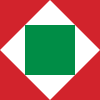 |
 |

| |||
| 1805年-1814年 | 君主立宪制 |  |
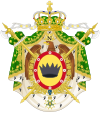 |

| ||
| 1806年-1810年[7] |  |
 |

| |||
| 莱茵邦联 | 1806年-1813年 | 邦联制 |  |
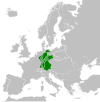
| ||
| 1807年-1813年 | 君主制 |  |
 |

| ||
| 1808年-1813年 | 君主立宪制 |  |
 |

| ||
| 1913年 | 共和制 |  |

| |||
| 1918年–1919年 |  |

| ||||
| 1920年–1922年 |  |
 |

| |||
| 1939年-1945年 | 保护国 |  |
 |

| ||
| 1939年-1945年 | 共和制 |  |
 |

| ||
| 1939年-1943年 | 保护国 |  |

| |||
| 1939年-1940年 | 共和制 |  |
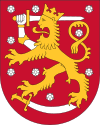 |

| ||
| 1940年-1944年 |  |
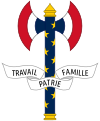 |

| |||
| 1941年-1944年 | 自治区 |  |
 |

| ||
| 1941年-1944年 | 共和制 |  |
 |

| ||
| 军政 |  |
 |
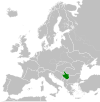
| |||
| 1941年-1945年 | 君主立宪制/共和制 |  |
 |
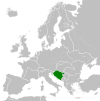
| ||
| 1943年-1944年 | 保护国 |  |
 |

| ||
| 1943年-1945年 | 共和制 |  |
 |

|
| 国家 | 支配国 | 时间 | 政治体制 | 国旗 | 国徽 | 地图 |
|---|---|---|---|---|---|---|
| 西梁 | 西魏、北周、隋朝 | 555年-587年 | 君主制 | 
| ||
| 东丹 | 辽朝 | 926年-952年 | 
| |||
| 迦托诃 | 1017年-1067年 | |||||
| 楚 | 1127年 | |||||
| 齐 | 1130年-1137年 | |||||
| 1932年-1945年 | 君主立宪制 |  |
 |

| ||
| 1935年-1938年 | 共和制 |  |

| |||
| 1936年-1937年 |  |
|||||
| 1937年-1939年 |  |

| ||||
 |

| |||||
 |
 |
|||||
| 1937年-1938年 |  |

| ||||
| 1937年-1940年 |  |

| ||||
| 1938年-1940年 |  |

| ||||
| 1939年-1945年 |  |
 |

| |||
| 1940年-1945年 |  |
 |

| |||
| 1942年-1945年 |  |
 |

| |||
| 1941年-1945年 | 君主立宪制 |  |
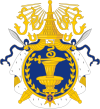 |

| ||
| 1943年-1945年 | 共和制 |  |
 |

| ||
 |
 |

| ||||
| 1945年 | 君主制 |  |
 |

| ||
| 1945—1952年 | 军事占领 |  |
 |

| ||
| 1946年-1949年 | 共和制 |  |
 |

| ||
| 1949年-1955年 | 君主立宪制 |  |
 |

| ||
| 1975年–1976年 | 共和制 |  |

| |||
| 1979年-1989年 |  |
 |

| |||
 |
 |

| ||||
| 1990年 |  |
 |

|
| 国家 | 支配国 | 时间 | 政治体制 | 国旗 | 国徽 | 地图 |
|---|---|---|---|---|---|---|
| 1960年-1963年 | 共和制 |  |
 |

| ||
| 1966年-1990年 |  |
 |

| |||
| 1976年-1994年 |  |
 |

| |||
| 1977年-1994年 |  |
 |

| |||
| 1979年-1994年 |  |
 |

| |||
| 1981年-1994年 |  |
 |

|
| 国家 | 支配国 | 时间 | 政治体制 | 国旗 | 国徽 | 地图 |
|---|---|---|---|---|---|---|
| 1810年 | 共和制 |  |

| |||
| 1846年 |  |

|
| 国家 | 支配国 | 时间 | 政治体制 | 国旗 | 国徽 | 地图 |
|---|---|---|---|---|---|---|
| 1842年-1880年 | 君主制 |  |
 |
|||
| 1871年-1874年 |  |
 |

| |||
| 1887年-1893年[8][9] | 君主立宪制 |  |
 |

| ||
| 1894年-1898年[10] | 共和制 |  |
 |

|
现代被认为的政权
[编辑]此章节的准确性有争议。 |
| 国家 | 背后国家 | 时间 | 政体 | 国旗 | 国徽 | 地图位置 |
|---|---|---|---|---|---|---|
| 1974年-至今 | 共和制 |  |
 |
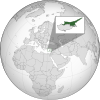
| ||
| 1991年-2023年 | 
|

|

| |||
| 1991年-至今[11][12][13][14] |  |
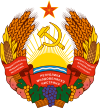 |

| |||
| 1991年-至今[15] |  |
 |

| |||
| 1992年-至今[16][17] |  |
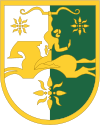 |

| |||
| 2014年-2022年[18][19] |  |
 |

| |||
| 2014年-2022年[18][19] |  |
 |

|
参考资料
[编辑]- ^ Marek, Krystyna. Identity and Continuity of States in Public International Law. Library Droz. 1954: 178 [2019-11-20]. ISBN 9782600040440. (原始内容存档于2020-12-18).
[...] an allegedly independent, but 'actually' dependent, i.e. puppet State [...].
- ^ Puppet government (页面存档备份,存于互联网档案馆), Merriam-Webster
- ^ Raič, David. Statehood and the Law of Self-Determination. Kluwer Law International. 2002: 81 [13 September 2017]. ISBN 90-411-1890-X. (原始内容存档于2020-12-18).
In most cases, puppet States are created by the occupant during occupation of a State, for the purpose of circumventing the former's international responsibility regarding the violation of the rights of the occupied State.
- ^ quote = The creation of puppet states or of puppet governments does not give them any special status under international law in the occupied territory. Therefore the puppet governments and puppet states have no greater rights in the occupied territory than the occupant himself. Their actions should be considered as actions of the occupant and hence subject to the limitations of the Hague Regulations. }}
- ^ Shapiro, Stephen. Ultra Hush-hush
 . Annick Press. 2003: 38. ISBN 1-55037-778-7.
. Annick Press. 2003: 38. ISBN 1-55037-778-7. Puppet state: a country whose government is being controlled by the government of another country, much as a puppeteer controls the strings on a marionette
- ^ Acton, J.E.E.D.A., Ward, A.W., Prothero, G.W., Leathes, S.M., Benians, E.A. (1907) The Cambridge modern history. Vol. 8, p. 288.
- ^ Jonathan Israel, The Dutch Republic: Its Rise, Greatness, and Fall 1477-1806. Oxford: Oxford University Press 1995, 1128.
- ^ Caryl-Sue. Bayonet Constitution. National Geographic Society. 2020-04-06 [2022-01-02]. (原始内容存档于2022-04-20) (英语).
- ^ Schulz, Joy. Hawaiian by Birth: Missionary Children, Bicultural Identity, and U.S. Colonialism in the Pacific. University of Nebraska Press. 2017: 1–238. ISBN 978-0803285897.
- ^ Public Law 103-150 - Wikisource, the free online library. [2022-04-08]. (原始内容存档于2022-04-17).
- ^ Robertson, Dylan C. Is Transnistria the ghost of Crimea's future?. The Christian Science Monitor. 5 March 2014 [25 October 2015]. (原始内容存档于2017-06-16).
- ^ Ivanel, Bogdan. Puppet States: A Growing Trend of Covert Occupation. Yearbook of International Humanitarian Law Volume 18, 2015. Yearbook of International Humanitarian Law 18. 2016: 43–65 [2022-04-26]. ISBN 978-94-6265-140-1. ISSN 1389-1359. doi:10.1007/978-94-6265-141-8_2. (原始内容存档于2022-05-27).
- ^ Neopatrimonialism and Regime Endurance in Transnistria (PDF). [2022-04-26]. (原始内容 (PDF)存档于2022-03-13).
- ^ Chapter 7: The European Unions position and practice with regard to unilateral and extraterritorial sanctions. [2022-04-26]. (原始内容存档于2022-03-28).
- ^ Ivanel, Bogdan. Gill, Terry D. , 编. Puppet States: A Growing Trend of Covert Occupation 18. The Hague: T.M.C. Asser Press: 43–65. 2016. ISBN 978-94-6265-140-1. doi:10.1007/978-94-6265-141-8_2 (英语).
- ^ Coffey, Luke. Georgia and Russia: The occupation too many have forgotten. thecommentator.com. 1 June 2012 [13 September 2017]. (原始内容存档于20 December 2013).
- ^ Francis, Céline. Conflict Resolution and Status: The Case of Georgia and Abkhazia (1989–2008). VUBPRESS Brussels University Press. 2011: 92–97 [13 September 2017]. ISBN 978-90-5487-899-5. (原始内容存档于2022-05-23).
- ^ 18.0 18.1 Vikhrov, Maxim. The Luhansk Coup: Why Armed Conflict Erupted in Russia’s Puppet Regime. Carnegie Endowment for International Peace. [2022-04-27]. (原始内容存档于2022-05-25) (英语).
- ^ 19.0 19.1 「分離主義」的無奈:脱離民眾的「民族自決」,如何成為俄羅斯區域霸權的傀儡. 端媒体. 2022-03-14 [2022-04-12]. (原始内容存档于2022-04-04).
